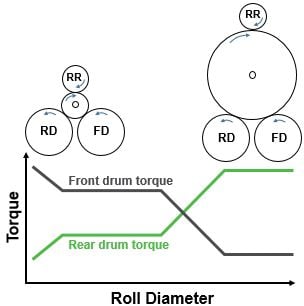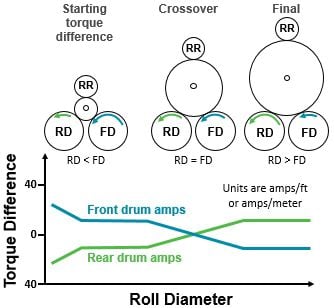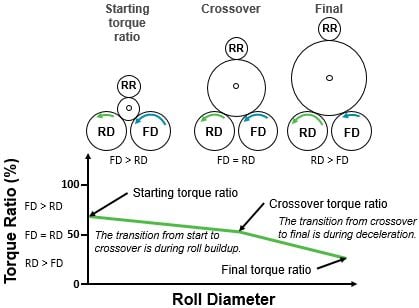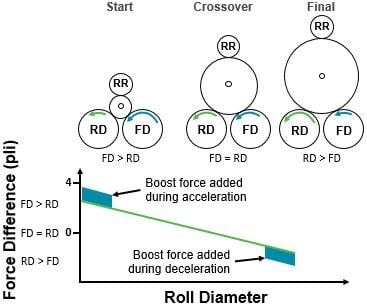Winding principles part 3 - drum torque control methods, summary
Dec 13, 2016
This article is the last in a short series which explains how web tension, rider roll pressure, and drum torque ratio affect roll quality. Illustrations of key components and control principles will be presented. The previous articles presented an overview, then the tension control and nipload variables. This article will discuss drum torque ratio.
Drum torque control
Valmet's technical studies have found that drum torque has a very predictable effect on roll hardness. When web tension and drum nip pressure remain constant, drum torque is an excellent means for assuring that rolls will have uniform or diminishing hardness from the core toward the outside of the rolls.

Figure 6 Front and rear drum torque vary as roll diameter increases
Front vs rear torque
Simply stated, front drum torque tends to tighten the wind and increase hardness. Rear drum torque tends to loosen the wind and decrease hardness.
Drum torque control techniques
There are three types of systems commonly used on Valmet two drum winders. They are Torque Difference, Torque Ratio and Drum Force difference. All three systems use torque difference between the drums to control roll hardness. Each system has advantages and disadvantages that will affect the choice of the system selected for a particular winder.
Torque difference control
Torque difference control is usually used on older winders. This system (Figure 7) uses amps/foot or amps/meter as its unit of measurement. This is very effective as the armature amps of a DC motor can be readily converted to torque.

Figure 7 Torque difference control
Torque ratio control
Torque ratio is effective on small complex winders but should not be used on large high speed machines with high horsepower requirements. This system splits the total load on the front and rear drum according to a percentage setting (Figure 8). While this allows the acceleration and deceleration current to be split according to a percentage (additional current can be used during acceleration and deceleration to overcome the inertia of the paper roll) on large winders the extra current can become excessive. Too much torque difference between the drums will cause slippage which will lead to roll set stability problems.

Figure 8 Torque ratio control
Drum force difference
Drum force difference control is used on high speed complex winders with high horsepower requirements. This system uses PLI or force as its unit of measurement and control. This means that the force difference is always specified regardless of total load between the drums (Figure 9). Paper roll inertia is allowed for by a boost force added to the basic force setting.

Figure 9 Drum force difference control
Control as the set grows
Beginning of set
At the beginning of each set, the front drum should provide more torque than the rear drum, thereby adding to the tightness of the wind near the core. As the winding proceeds, the front drum torque should be reduced and the rear drum torque should be increased (see Figures 7-9).
At the crossover
At some point in the second half of the set, depending on shipping roll diameter, the rider roll will be fully relieved. From this point on, roll structure is controlled solely by drum torque ratio. Normally, the front drum torque and rear drum torque reach equal levels or "crossover" at this point.
End of set
By the end of the set, the rear drum may provide more torque than the front drum depending on shipping roll diameter. This helps to soften the wind or at least prevent an increase in hardness toward the outside of the rolls.
Hardness control
Valmet's two drum winder control system allows you to specify a starting torque, crossover torque and finishing torque for each roll set. When properly set, these three controls will assure that your rolls are wound tightest at the core, with uniform or diminishing hardness toward the outside of the rolls.
Harder rolls
For harder rolls, select a higher starting torque and a higher finishing torque. That way, the drums will help tighten the winding near the cores and also keep the winding almost as tight near the outside of the rolls.
Gradual adjustments
Unless roll hardness has to be adjusted due to bad paper or for some other unexpected reason, the torque settings should not be changed during winder operation. If the settings do have to be adjusted, the changes should be made gradually. Sudden changes in torque can cause unwanted changes in roll hardness or even cause web breaks.
Summary of winder control variables
The achievement of uniform or diminishing roll hardness requires careful control of web tension, drum nip pressure and drum torque levels. The winder should be equipped with control systems for each of these parameters.
Best results are achieved when web tension is set at the minimum level required for good roll separation. Tension should be maintained at this level throughout each winding set.
Drum nip pressure should also be kept at a constant level during each winding set. This can be accomplished by using an automatic program for the rider roll relief pressure.
Drum torque settings should be adjusted to provide greater front drum torque at the beginning of the set and greater rear drum torque at the end of the set, with the break point occurring when the shipping rolls reach the diameter at which the rider roll is fully relieved.
For more information on winding principles and how to wind a perfect roll, contact your Valmet representative.